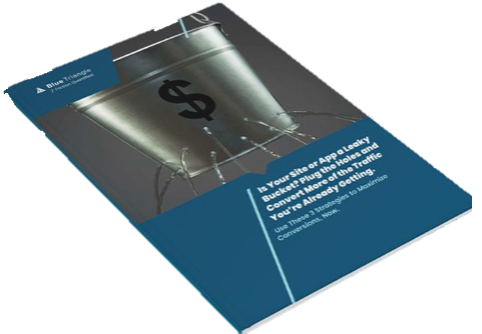Prioritizing Friction Points with the Most Potential to Move the Needle
Five ways to help your digital product teams focus efforts to remove user friction, prioritize new features and drive more revenue with A/B testing.
Companies spend millions of dollars each year performing user testing, analyzing site performance, and developing new features to keep their website and mobile app experiences fresh and performant.
Why? In most cases, it's to increase conversions and drive more revenue from their digital properties.
But the reality is that no company has unlimited resources for conversion rate optimization (CRO) and building new features. So, how should they prioritize which features to add, which features to remove, and which pages to improve to remove user friction and maximize conversions?
Show me the money, to quote Cuba Gooding's character in the movie Jerry Maguire.
Focusing on improvements that will drive the most increased revenue is at the heart of Jared Miller's approach to analytics for jewelry retailer Kendra Scott.
"We want to be more than a cost center," Jared, Senior Director of Web Analytics & Personalization, explained on a recent episode of The Frictionless Experience podcast. "We want to actually use the data to bring incrementality and incremental revenue to the business."

After all, why invest in making changes that don't result in increased revenue and improvements in customer trust and loyalty? Jared likens his approach to a "production conveyor belt."
"I take off the senior director hat, the managers take off the manager hats, and at some point, we're all just analysts, and we all have a target to hit on the incremental value," he explains. "It's almost like a production conveyor belt. Can we find an insight?"
How can companies approach their user testing and analysis to help focus both the analytics and product teams on driving more revenue?
Consider these five recommendations from Jared:
1. Incentivize Teams Based on Incremental Revenue Capture.
Aligning employee compensation with business objectives has proven to be effective in driving profitable change for many companies. Jared believes in offering monetary incentives for his team based on insights they uncover and recommendations they provide based on how much additional revenue they drive.
"We want to be more than just report writers or more than just people to collect data or think about how the data is presented in the tool," he explains. "The way we do that is everybody on the team is goaled to bring a certain amount of incremental revenue annually through data, and evangelizing that data and hypothesizing from it and then testing and proving value."
2. Focus on Insights, Not Perfect Data.
"We frequently get caught up in technology or data when the reality is we don't need that much data to make good decisions and have good insights," Jared notes. Striving for perfect data prevents making rapid improvements in user experience that can drive significant revenue increases for the company.
"I'm not even convinced that the data has to be perfect," he notes. "So, is this the wow moment? I don't know. Right. I don't think you need perfect data for these things." Jared recommends balancing speed and precision in A/B testing and personalization.
3. Include User Testing to Identify Areas of Improvement.
Teams too often focus on technology and data and overlook the most important thing: the customer. "If you're leading the discussion with your technology or your platform or the data, I think that's a miss," Jared explains.
The solution? "We should be leading with the customer!" he recommends. This means performing constant user testing and customer interviews to uncover opportunities for improvement and then leading with a story and hypothesizing opportunities to remove friction and maximize conversions.
4. Learn to be Data Storytellers.
Jared believes good storytelling is the key to conveying data effectively and engagingly, which helps in product testing. Combining data with expertise and telling a meaningful story is vital in creating successful digital products.
It's something he works hard to teach his team so they have the skills to make their data come alive and gain buy-in on recommendations, using his proverbial "conveyor belt" process. "How do we design a process to regularly combine the data with our expertise and tell a story, right?"
5. Achieve Nonlinear Gains Through Collaboration.
Jared believes that through collaboration and sharing of expertise, individuals can learn from each other, often leading to nonlinear gains in the team's performance. A more comprehensive and impactful outcome can be achieved by pooling together different perspectives and approaches, even if it means initial discomfort or resistance from certain team members.
Jared likens it to the famous "Stone Soup" approach from a Nordic fairytale his kindergarten teacher told students, whereby you combine individual contributions to create a richer collective result.
"There's a traveler walking to town and picks up a rock and knocks on the first door and says, 'Hey, if you put on some boiling water, I'll make you the best soup you ever had.'" He then has the homeowner and her neighbors add carrots, celery, broth, and water to create a delicious soup.
"The community made the soup; they made it together, right?" he explains, much like a combined team of analysts, product managers, and UX experts can craft more amazing digital experiences than any individual contributor.
These five principles summarize Jared's approach to successful product improvements, which he uses at Kendra Scott, and previous digital analytics stints with Gap, Inc. and Pandora.
Are you looking for a shortcut to identifying the biggest revenue opportunities on your company's digital properties? Utilize a tool capable of quantifying user friction on your company's digital properties. By quantifying the cost of each friction point, you can quickly uncover the opportunities for the greatest revenue gains and focus user testing and product development efforts on those pages and features.
In the end, the goal should be to focus your entire team on the money: those user experience improvements that will drive the biggest revenue gains for your company.

During the holiday rush, every shopper matters
Optimize the customer journey before the eCommerce event of the year.

.jpg)

